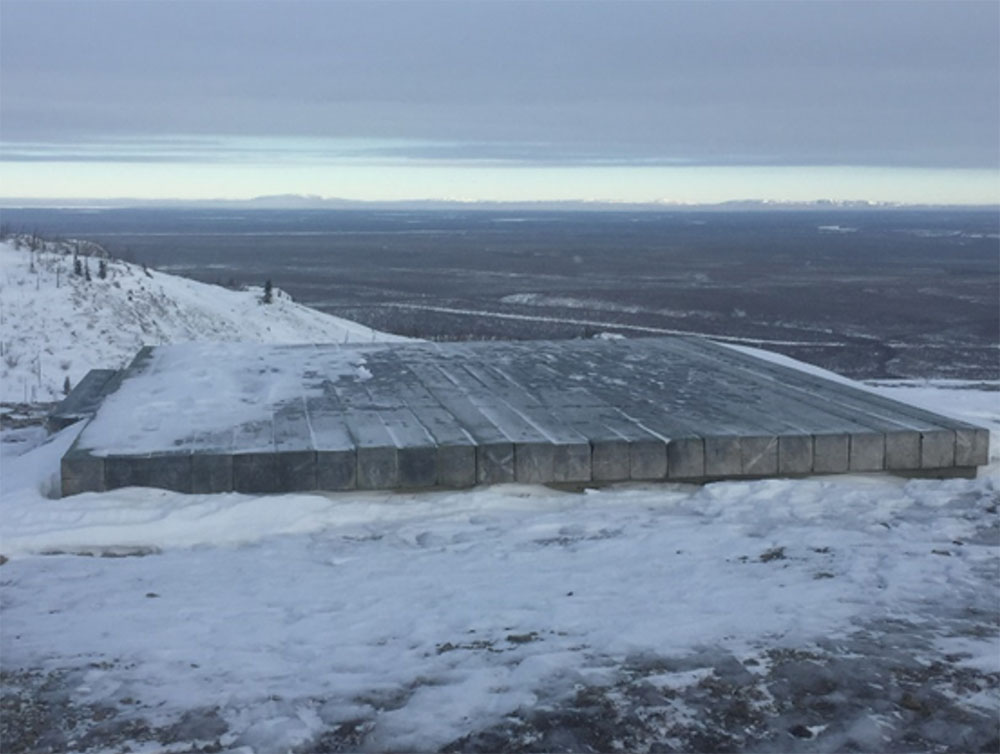AS350B2 Accident After Vibration from Unrecorded Maintenance
On 15 February 2018, Sahtu Helicopters (a subsidiary of Great Slave Helicopters) Airbus Helicopters AS350B2 C-FWCR landed on a 16 feet by 16 feet (i.e 0.27 D) helipad at a telecommunications tower at Bear Rock, Northwest Territories (NWT), and was shut down at 0958.
The landing site is 3 nm WNW of Tulita (NWT), where the recorded temperature was −27 °C.
According to the Transportation Safety Board (TSB) safety investigation report:
Approximately 30 minutes after landing, given the temperature at the time, the pilot conducted a first engine run as per the AS350B2 flight manual supplement Instructions for Operation in Cold Weather, because pre-heat was not available. On start-up, the pilot felt vibrations consistent with those felt over the previous 3 days, both on the ground and during flight [see below].
At 1108, the pilot initiated the engine-start sequence for another engine run. The engine started and accelerated normally to 70% gas generator speed (Ng). The pilot increased the fuel flow control to the flight position. As the throttle was increased, the helicopter began bucking fore and aft on the landing gear skids.
In response, the pilot decreased the fuel flow control, which increased the bucking. The pilot then decided to lift off in order to stop what he perceived to be ground resonance.
The investigators note that: “Ground resonance does not normally occur in rigid or semi-rigid rotor systems because there is no drag hinge. The AS350’s Starflex rotor system does not use lead-lag dampers
The fuel flow control was quickly increased and the collective raised; however, the fuel flow control was not fully advanced and locked into the flight gate. Neither the main rotor rpm nor the engine rpm accelerated to the flight-governing range before the helicopter became airborne.
The helicopter lifted several feet off the helipad, rotated to the left, and drifted approximately 30 m to the southeast. Given that the engine rpm had not accelerated into the flight-governing range, the rotor rpm subsequently drooped and the pilot was unable to maintain control of the helicopter.
…the helicopter descended, collided with terrain and came to rest 50 m downslope of the helipad.
The pilot was wearing the 4-point lap and shoulder harness, but was not wearing a helmet. He received serious injuries, but managed to egress the helicopter, return to the telecommunications tower service building, and contact the company to report the accident. The passenger who had been transported to the telecommunications tower administered first aid to the pilot. A company helicopter was dispatched from Fort Simpson, Northwest Territories, and arrived at approximately 1500 to transport the pilot to medical facilities in Yellowknife, Northwest Territories.
The investigators reveal that:
On 11 February 2018, 4 days before the accident, the helicopter was placed in the Great Slave Helicopter hangar overnight. An aircraft maintenance engineer had removed the main rotor blades with the assistance of the occurrence pilot and placed them on a wheeled storage rack, which was positioned beneath the helicopter tail boom after the helicopter was placed in the hangar.
The TSB however don’t report why this was done.
After reinstalling the main rotor blades on the morning of 12 February 2018, the occurrence pilot conducted an engine run, during which vibrations were noted. The vibration levels were not verified using vibration analysis equipment, which was available at the maintenance hangar. The blade tip tracking and dynamic balancing were not checked, as prescribed in the aircraft maintenance manual.
…no entry was made in the aircraft journey log for either the removal or the installation of the rotor blades. The investigation found that it was the maintenance provider’s routine practice to do this type of work without making entries in the aircraft journey log.
The pilot subsequently flew the helicopter for 6 hours before the occurrence and the vibration continued. During this time, no action was taken to verify or rectify the vibration and no aircraft journey log entries were made.
Information on the pre-accident tracking and balance condition of the rotor system was not available (because it was not recorded by maintenance) and was impossible to obtain post-accident.
TSB Safety Messages
- The success of recovery when encountering possible ground resonance depends on appropriate action relevant to the main rotor speed.
- It is important to record maintenance activities in the aircraft journey log and follow maintenance procedures, for example when removing and installing main rotor blades.
- Wearing the available lap and shoulder harnesses and a helmet is key to preventing injury in rollover accidents in which the potential for head injury is high.
Safety Action
- On 26 June 2018, Great Slave Helicopters Ltd. management sent an email to all company pilots and aircraft maintenance engineers, reminding them of the requirement to enter blade removal and installation in the aircraft journey log.
- An audit cycle was added to monitor the blade removal and installation events.
- Company pilots were reminded, in recent training classes, of the requirement to record any sudden changes in vibration levels in the aircraft journey log.
Safety Resources
Aerossurance worked with the Flight Safety Foundation (FSF) to create a Maintenance Observation Program (MOP) requirement for their contractible BARSOHO offshore helicopter Safety Performance Requirements to help learning about routine maintenance and then to initiate safety improvements:
Aerossurance has previously written on these associated topics:
- Airworthiness Matters: Next Generation Maintenance Human Factors Over the last 10-15 years, much attention has been focused on maintenance human factors training and reporting & investigating errors. While we could concentrate on simply doing more of these and certainly can find ways to do these things better, perhaps the next generation approach needs to include a much wider range of activities.
- Aircraft Maintenance: Going for Gold? Should we start treating maintenance personnel more like athletes who need to achieve peak performance every day?
- The Power of Safety Leadership
- Leadership and Trust
- Safety Performance Listening and Learning – AEROSPACE March 2017
- How To Develop Your Organisation’s Safety Culture
- James Reason’s 12 Principles of Error Management
- Back to the Future: Error Management
- B1900D Emergency Landing: Maintenance Standards & Practices
- Fatal Wire Strike on Take Off from Communications Site
- Fire After O-Ring Nipped on Installation
- Coking Causes Power Loss: Australian AS350BA
- UPDATE 8 March 2019: Fatal S-61N Dual Power Loss During Post Maintenance Check Flight
- UPDATE 23 March 2019: Maintenance Misdiagnosis Precursor to Tail Rotor Control Failure
- UPDATE 1 April 2019: Tree Top Autorotation for B206L1 After Loose Fuel Line B-Nut Leaks
- UPDATE 1 September 2019: King Air 100 Stalls on Take Off After Exposed to 14 Minutes of Snowfall: No De-Icing Applied
- UPDATE 2 January 2020: EC130B4 Destroyed After Ice Ingestion – Engine Intake Left Uncovered
- UPDATE 27 December 2020: Fire-Fighting AS350 Hydraulics Accident: Dormant Miswiring
- UPDATE 16 January 2021: NZ Firefighting AS350 Accident: Weaknesses in Role Equipment Design and Distribution of Key Operating Data
- UPDATE 8 February 2021: RCAF Investigate Defect on Newly Delivered CH-148 Cyclone (S-92)
Aerossurance is pleased to be both sponsoring and presenting at a Royal Aeronautical Society (RAeS) Human Factors Group: Engineering seminar Maintenance Error: Are we learning? to be held on 9 May 2019 at Cranfield University.





Recent Comments